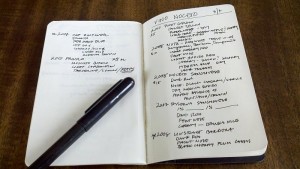
Typical page of notes for a winery.
On my recent Gold Country wine tasting trip, I travelled with a group of friends. Some of them were using my book, Pour Me Another, to keep track of their tasting and to get an overview of each of the wineries that we visited. I encourage wine drinkers to keep track of the wines they taste when they are out tasting. I have posted about this before.
It was the end of our first day of tasting. We were at Crystal Basin Cellars. We had been tasting all afternoon. I leaned over to my friend as he was making a note in the book and asked, “What do you think of this wine?”
He looked at me with a little bit of fear and said, “I don’t know any of the language to describe wines. I just wrote ‘yum!’”
“That’s perfect!” I said. And I meant it. I continued, “When I was writing my book, I used my tasting notes. For one entry, I referred back to my notes about a specific wine and found that all I’d written was, ‘I wish I had a car this color’”.
My friend laughed and relaxed. Taking notes for me, somebody who is writing about wine, is a different activity than for others who don’t aspire to that, though clearly, my note taking skills need improvement. For my friend, it was enough to write “yum!” because that summed up what he needed to know about that wine: he liked it…he really liked it.
And his simple note inspired me to continue my struggle to write about wine without falling into one of the two camps of tasting note writing. The first group is the one we are most familiar with: lots of descriptions of smells and tastes using words like floral, smokey, jammy, stone fruit, cherry, and all the rest. The second group sticks solely to the facts: what grape varietals are used to make it, where it’s from, how much alcohol it has and whether it is a simple or complex wine.
Some notes combine both these methods. But these kinds of notes don’t tell me what it’s like to drink the wine. That is my goal as a writer about wine: finding a way to write about a wine that avoids the clichés of the overly descriptive tasting note and provides more subjective information than the purely factual tasting note. I have come nowhere near achieving this goal, but it’s where I’m headed.
I’d love to hear what you think about tasting notes and how you use them.
“Yum”, is it the new language of wine?
Related Posts :
I used a small paper bound Moleski ...
The Roman god Bacchus as imagined ...
Recently at the 2011 Wine Bloggers’ Conference, Eric Asimov, the NY Times wine critic, and Janic ...


